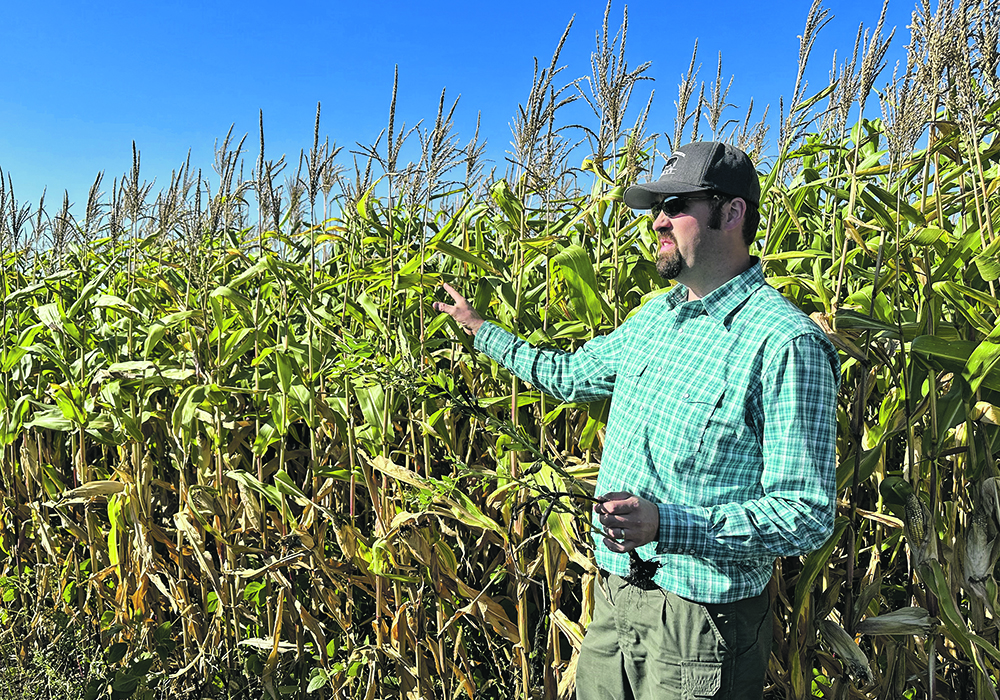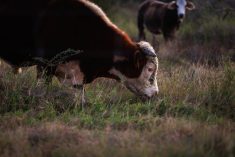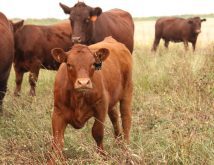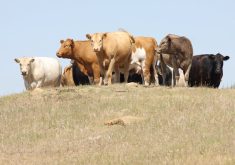Cattle producer says there are wrinkles still to work out, but a new winter grazing technique shows good potential
Glacier FarmMedia – The drought in 2021 sparked a shift for the Bouw brothers, owners and operators of Edie Creek Angus near Anola, east of Winnipeg.
“Our journey has always been about animals that are functioning on the land without much input,” said Jonathan Bouw, speaking at a recent field tour.
That philosophy ran headlong into a long stretch of dry years, cumulating in historic drought conditions that forced many Manitoba beef farms to cull animals. Edie Creek Angus was one of them.
Read Also

Trump’s tariffs take their toll on U.S. producers
U.S. farmers say Trump’s tariffs have been devastating for growers in that country.
At the time, many of those hoping to minimize herd cuts turned to novel feeds like agri-food byproducts or grain. For grass-fed operations like the Bouws, that wasn’t an option.
“We just weren’t making it,” Bouw said during the recent tour. “We’d done three or four years of drought, and we’re only selling 25-ish finished animals at a time from our culled cows, and maybe another 20 as grass-finished beef animals, so 45 head total.
“Then we had another 600 head that are living and not turning an income from that grass-fed beef enterprise.”
In 2021, they decided to grow corn for its drought-resilient properties. For over a decade, the brothers stood by the notion that cattle have four stomachs because they process low-quality fibre into high-quality meat, and considered corn to have unnecessarily high energy.
“But the idealistic thing is gone by the wayside because of economics,” said Bouw.
They began corn grazing in earnest by the winter of 2022. While they had good results, there were challenges, such as cattle breaking into the next parcel of corn before the brothers were ready to move them.
That was a potential danger in a corn grazing system, where parcel size, hay supplements and herd movement are carefully managed to encourage uptake of lower-quality material and reduce the temptation for cattle to gorge on cobs.
“There’d be 10 to a dozen cows that were looking poor for a week straight because of acidosis,” said Bouw. “Their guts were on fire and their feet were sore.”
Last year, the brothers tried something new — winter grazing with mini corn piles.
Bouw credited the idea to problems in fall 2019, when late rain and early snow interrupted grain harvest and complicated corn silaging operations, making it “the harvest from hell.”

“In 2019 around here, it was a super wet fall and feedlots, as well as other guys, chopped corn way later than normal,” said Bouw. “They put them in piles, they packed them, they covered them and it never ensiled. So that’s where I got this idea from.”
Mini corn pile grazing is like bale grazing but with chopped corn dropped into small piles across the field. Daily herd moves control intake.
“The idea here is to make a balanced diet for them, make them use the whole stalk,” said Bouw. “We put a little money into it because we are chopping it. But you’re trying to get the rumens happy all the time.”
Beyond goals like a more balanced diet and healthier rumens, the process reduces work load and allows the Bouws to keep calves on cows longer, even when the weather turns harsh. It also makes use of the entire plant and reduces fertilizer needs.
The idea was to chop in late November or December and drop small tandem loads, spreading each pile into roughly 20-skid-steer-bucket piles.
“We chopped around Nov. 29, and it was really warm. It was above zero, and that worked against us,” said Bouw. “It was a little too warm. So, in the end, these piles did start to heat.”
They pulled the piles apart to stop spoilage, but Bouw said mould developed in some piles, with related effects on the herd.
“I think we did have a couple more cows slip calves. By the time we got to calving, there were some cows that didn’t calve that had been pregnant. The mould side of that thing is definitely the number one concern.”
Overall, he said the experiment was a financial success. Calculating total feed costs, including the cost of growing the corn and supplementing the diet with hay bales to add protein, the Bouws spent roughly $320 per acre. The cost of chopping the corn, at $10 a tonne, worked out to $150 an acre. Total expenses were $470 per acre.
They calculate the value of grazing 220 pairs at $3.50 per day as $770 an acre. The value of the 50 bred heifers was calculated at $1.75 a day, for $90 an acre. All said, they put the estimated value produced at $860, making for a profit of $410 per acre.
There are several adjustments to make, Bouw said. The first is limiting spoilage. In a future year, they would try to chop when the chill had already set in, and would make smaller piles.
He also has ideas to make the process more efficient.
“I thought of taking our high dump wagon and cutting the flat wall and turning it into a gate opening system so that you could just drive along with the chopper, blowing into the high dump, and every 45 seconds the high dump could open the side door and just drop a pile,” said Bouw.
“There’s going to be better ways if we actually want to keep doing this in the long term.”
















